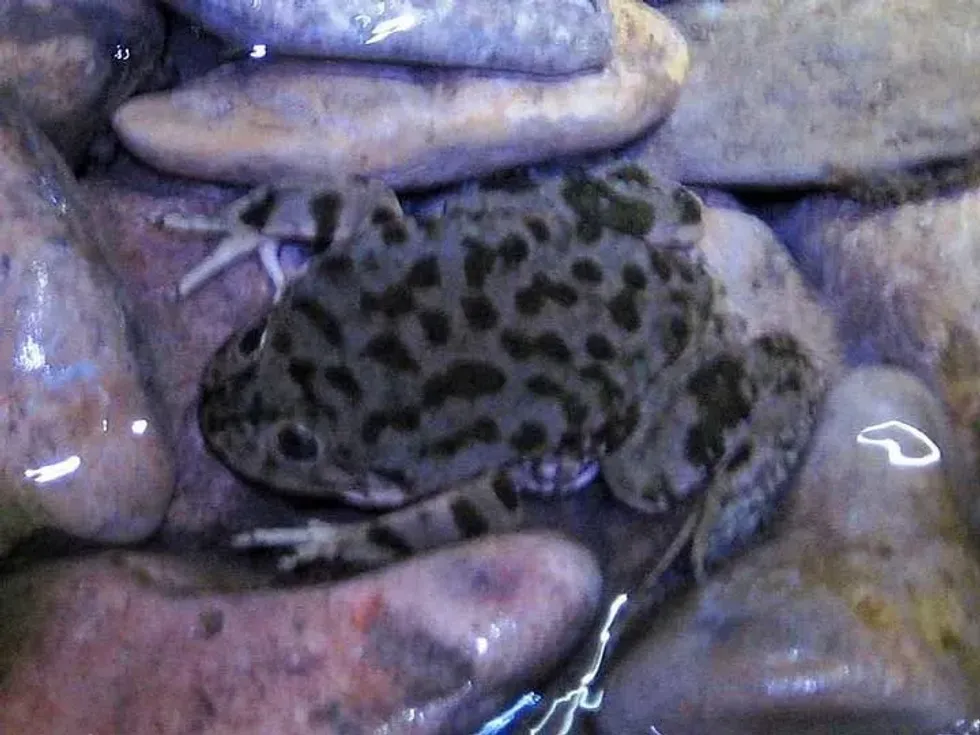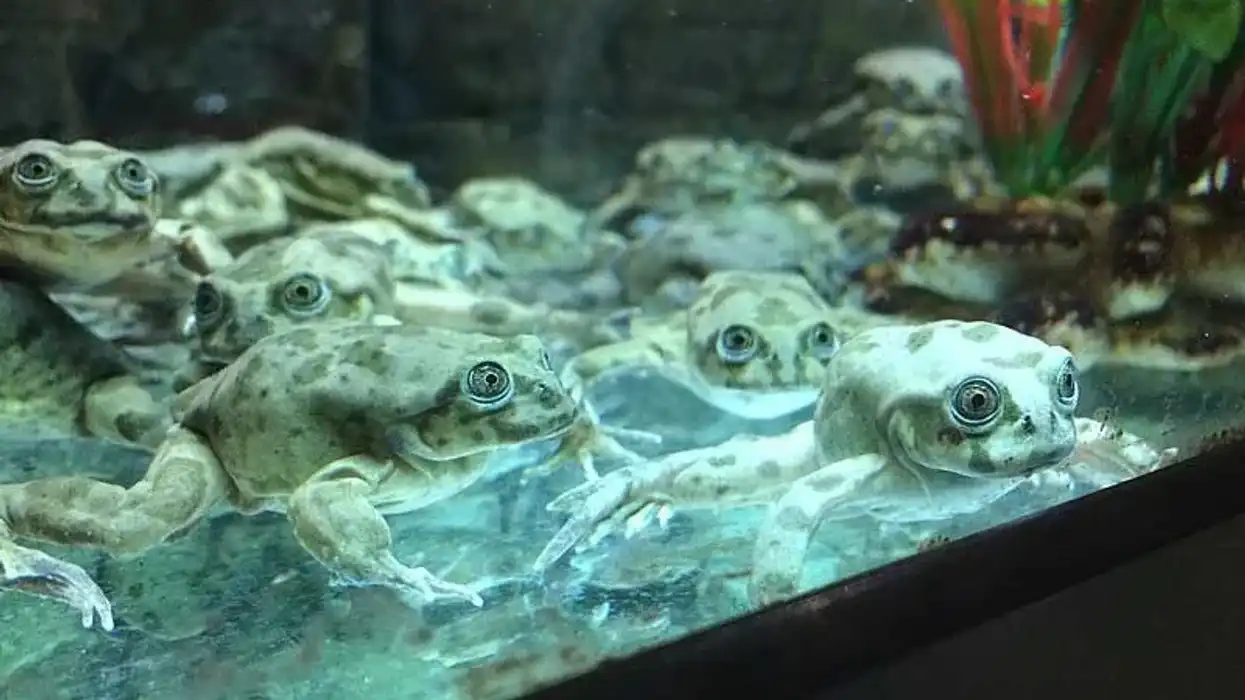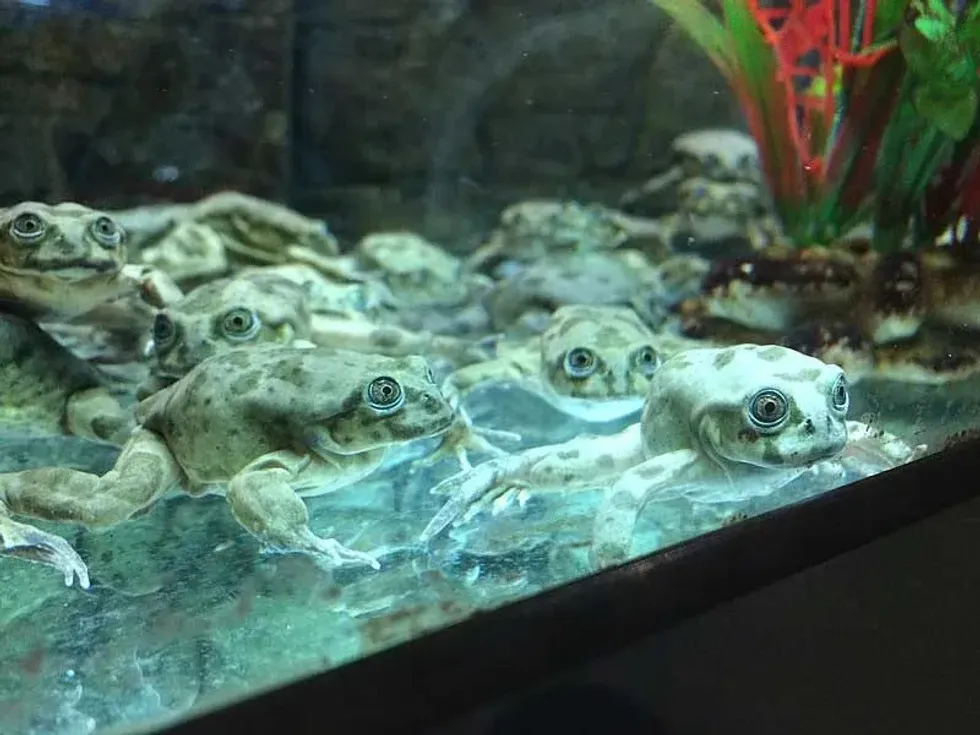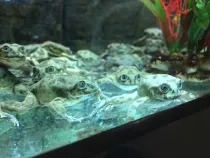Fun Lake Titicaca Frog Facts For Kids

The Lake Titicaca water frog (telmatobius) is a fully aquatic amphibian endemic to the South American content in countries like Bolivia and Peru.
The Lake Titicaca frog (telmatobius) inhabits the Titicaca lake and other connected water bodies near the Peru-Bolivia border. The Titicaca water frog lives most of its life swimming in the deeper layers of the water bodies.
The Titicaca water frogs exhibit colors like olive green, dark green, gray and black.
The Titicaca water frog weighs about 0.6-0.9 lb (0.25-0.4g) and measures 3-6.7 in (7.5-17 cm) in length from snout-to-vent which makes them one of the largest aquatic frogs, an outstretched individual can be about 20-30 cm in length.
The Goliath frog that ranks as the world's largest frog and the American Bullfrog with the crown of the largest American frog, has not left the Titicaca water frog much far behind whereas the Paedophryne amauensis which is even smaller than a coin, sets great contrast with the frog of this species.
This species of frog has been kept in conservation centers for its fast declining population.
If you like what you read, do check out these marsh frog facts and Columbia spotted frog facts.
Lake Titicaca Frog Interesting Facts
What type of animal is a Lake Titicaca frog?
The frogs in Lake Titicaca are amphibians of the Telmatobius culeus species of frogs, endemic to the Titicaca lake, Bolivia, Peru in South America.
What class of animal does a Lake Titicaca frog belong to?
Titicaca frogs belong to the class of Amphibia under the kingdom of Animalia.
How many Lake Titicaca frog are there in the world?
The population of this particular species of aquatic frog in Lake Titicaca was evaluated in 2019 as approximately 50,000 in their natural habitat and there are about 3000-3500 frogs at the captive breeding centres in the artificial conservation centres.
Where does a Lake Titicaca frog live?
The titicaca water frog lives most of its life in waters of the lake and few other smaller lakes that are connected to the Titicaca Lake such as the Peruvian Lake Arapa, Lake Lagunilla, Lake Saracocha across the Peru-Bolivian border.
What is a Lake Titicaca frog's habitat?
The water frog (Telmatobius culeus) is endemic to the continent of South America and is found living in Lake Titicaca. They are found to inhabit the deeper waters near the surface of the bed of the water bodies although they swim towards the shore for breeding purposes during the summer season.
Who do Lake Titicaca frog live with?
In the wild, the frogs of this species of Telmatobius culeus are found living in armies across the deep waters near the surface of the lake's bed. These frogs spend most of their life dwelling in the deep waters of the lake lying amidst the member frogs of the army.
In Bolivian and Peruvian conservation centres and museum, they are conserved within the man-made environment where they are kept with other frogs, forming armies.
How long does a Lake Titicaca frog live?
Lake Titicaca frog (Telmatobius) is found to live approximately for about 20 years in breeding centres and other conservation centres, however, the life span of these frogs living in their natural or wild habitat is yet to be discovered.
How do they reproduce?
These aquatic frogs living in Titicaca Lake spend most of their life inside the deep waters near the surface of the lake's bed. Males are believed to produce mating sounds for courting the female frogs, they swim to the shallow waters of the lake for breeding purposes.
They mate usually during the summer season, both the male and female frogs release eggs and sperm, and the fertilization takes place outside their body in the shallow water medium near the shore.
The female frogs lay about 80-500 eggs, the process of sperm-egg fertilization and hatching of eggs takes approximately 1-2 weeks. The tadpoles take about several months for developing into full-grown frogs through the transformation process named metamorphosis.
What is their conservation status?
In their wild habitat, Titicaca frogs are listed as Endangered right after its critically endangered relative, the amphibian species of Benavides.
The Benavides are native to northern Chile.
The Titicaca frog (Telmatobius culeus) is fast moving towards being critically endangered due to increasing pollution and the poaching of these frogs for human consumption, predatory animals like snakes and other factors like diseases are also responsible for the decline in their population.
They lay about 500 eggs per breeding season, however the introduced trout which are known to eat their tadpoles and larvae are also responsible for the drastic decrease in their population over the past 15 years and hence the species is presently regarded as endangered by the IUCN red list.
Environmentalists and conservationists have started taking certain measures for their conservation like captive breeding for saving them from becoming critically endangered and improving their status of being endangered and normalize their population count.
Lake Titicaca Frog Fun Facts
What do Lake Titicaca frog look like?
The Endangered Titicaca frog (Telmatobius culeus) is found to be variously colored, ranging from olive green to dark green, gray and brown with small dark patterns all over its back.
These frogs have an extra layer of skin folds that helps them to breathe in oxygen dissolved in the lake water, the skin folds also help them to stay warm at a higher altitude temperature.
The frogs of this species weigh about 0.6-0.9 lb (272.1-408.2 g) and measure 3-6.7 in (7.6-17 cm) in length from snout-to-vent which makes them one of the world's largest aquatic frogs, an outstretched individual can be about 7-12 in (20-30 cm) in length.
They have a wide and flathead with short and undivided tongues, a round face with large bulging eyes, they have a slimy body with thick skin folds that are filled with secretions to protect them from predators or enemies.
They have comparatively longer hind legs.

How cute are they?
This species of Titicaca frogs are google-eyed with appealing body colors, ranging from olive green to dark green and brown, they are extremely peace-loving creatures with very low metabolic rate, some herpetologists may find cute enough reasons to conduct more researches about their unique features.
How do they communicate?
This amphibian, living in the lakes of Peru and Bolivia, spend most of their life living underwater, they are believed to produce sounds as a gesture of courting its partner during the mating seasons.
How big is a Lake Titicaca frog ?
A Titicaca water frog is about 0.6-0.9 lb (272.1-408.2 g) in body weight and measures 3-6.7 in (7.6-17 cm) in length from snout-to-vent, this species is much larger than its close relative as the critically endangered species of the Benavides.
An individual of this species, when outstretched, can be even more than 20 cm long, thus making these animals one of the largest species of aquatic frog in the world.
When compared to the goliath frog, this frog fall short in length as the goliath frog is 12-13 in (30.4-33 cm) long.
How fast can a Lake Titicaca frog jump?
These frogs are found to be least interactive with the external world outside the lake, they mostly dwell amidst the deeper layers of the water body, they have extremely low metabolic rate and hence the facts about their jumping skills have not been precisely evaluated.
How much does a Lake Titicaca frog weigh?
A Titicaca water frog weighs about 0.6-0.9 lb (272.1-408.2 g), they contain a thick layer of skin folds to protect them from the high altitude cold temperatures which in turn adds up to their total body weight.
What are the male and female names of the species?
Unfortunately, herpetologists have not designated any specific names to the male and female individuals of the species.
What would you call a baby Lake Titicaca frog?
The little creatures that hatch from the female frog's eggs are named tadpoles who goes through the physical transformation or the process of metamorphosis and become young frogs, however, younger frogs have not gained any specific name.
What do they eat?
These creatures (especially the adults) are carnivorous. They are found to eat a variety of food as snails, small fish, smaller frogs, marine insects, crustaceans. They are even found to exhibit cannibalism and are found eating the flesh of other frogs. In conservatory centres, they feed on small worms and insect larvae.
Are they poisonous?
Frogs like poison frogs can be dangerous. Amphibians generally have glands beneath their skin that secretes poisonous fluids however the ones kept in artificial habitats lack the alkaloids that are high in toxicity.
This species too secrete similar poisonous fluids from the skin of their body, however, the fluids are not very poisonous or deadly and hence these frogs are widely hunted by poachers for human consumption of their flesh and for other purposes.
Would they make a good pet?
These creatures are fully aquatic and are found living peacefully among the wildlife and rarely in the conservation centres. Petting them is discouraged due to their endangered status.
Did you know...
This aquatic frog has several layers of skin folds which have earned this species the name, 'scrotum'.
The skin folds have also let these frogs win fourth place in the British Science Associations as the 'ugliest animal' contest that took place in 2013.
The skin folds may make them look ugly yet these physical structures have benefited them for living in the high altitude regions by keeping them warm.
These folds are mostly important for the breathing mechanism of these creatures, they can stretch this extra skin to increase the surface area of their body which helps them to absorb more oxygen into their blood, these, in turn, increases the oxygen-carrying red blood cells for transporting for oxygen to the lungs.
Though they have small lungs which are only about one-third of their entire anatomy and the lungs being poorly developed, the external folds make up for the oxygen shortage.
Why is the Titicaca water frog endangered?
The Titicaca water frog (Telmatobius) is endangered mainly due to its hunting by humans.
In countries like Peru, these creatures are poached for different reasons, apart from flesh, they are used to make medicines which the local people believe to be the cure for several diseases however these claims by local people lack enough scientific evidence and hence their poaching is strictly prohibited to save the species.
Pollution has also added to the steeper decline of their population over the past 15 years.
The introduced trout in the Titicaca water bodies have been another serious cause for their fast decreasing population number, the trout fish is found to eat the larvae of these creatures, letting them drift towards being critically endangered.
What is the difference between a frog and a toad?
Frogs have relatively smoother skin than toads whereas toads have bumpy skin. Frogs have longer legs and hence can jump better than toads, toads prefer to spawn rather than jumping due to their comparatively shorter legs.
The tadpole of a frog is leaner than a toad's younger one and has brighter color marks near its head whereas those of toads are plain black and chubby than the tadpole of a frog. Frogs are more water-loving than toads and are mostly found near wetlands, ponds and lakes.
Here at Kidadl, we have carefully created lots of interesting family-friendly animal facts for everyone to discover! For more relatable content, check out these crocodile skink facts and common newt facts for kids.
You can even occupy yourself at home by coloring in one of our free printable lake titicaca frog coloring pages.
We Want Your Photos!
More for You
Bachelor of Arts specializing in Journalism and Mass Communication, Postgraduate Diploma in Sports Management

Moumita DuttaBachelor of Arts specializing in Journalism and Mass Communication, Postgraduate Diploma in Sports Management
A content writer and editor with a passion for sports, Moumita has honed her skills in producing compelling match reports and stories about sporting heroes. She holds a degree in Journalism and Mass Communication from the Indian Institute of Social Welfare and Business Management, Calcutta University, alongside a postgraduate diploma in Sports Management.
Postgraduate Diploma in Management

Sakshi RaturiPostgraduate Diploma in Management
Sakshi has experience in marketing strategy, social media planning, and recruiting industry experts for capstone projects, she has displayed a commitment to enhancing their skills and knowledge. She has won multiple awards, including a Certificate of Appreciation for Creative Writing and a Certificate of Merit for Immaculate Turut, and is always seeking new opportunities to grow and develop.
Disclaimer
1) Kidadl is independent and to make our service free to you the reader we are supported by advertising. We hope you love our recommendations for products and services! What we suggest is selected independently by the Kidadl team. If you purchase using the Buy Now button we may earn a small commission. This does not influence our choices. Prices are correct and items are available at the time the article was published but we cannot guarantee that on the time of reading. Please note that Kidadl is a participant in the Amazon Services LLC Associates Program, an affiliate advertising program designed to provide a means for sites to earn advertising fees by advertising and linking to Amazon. We also link to other websites, but are not responsible for their content.
2) At Kidadl, we strive to recommend the very best activities and events. We will always aim to give you accurate information at the date of publication - however, information does change, so it’s important you do your own research, double-check and make the decision that is right for your family. We recognise that not all activities and ideas are appropriate for all children and families or in all circumstances. Our recommended activities are based on age but these are a guide. We recommend that these ideas are used as inspiration, that ideas are undertaken with appropriate adult supervision, and that each adult uses their own discretion and knowledge of their children to consider the safety and suitability. Kidadl cannot accept liability for the execution of these ideas, and parental supervision is advised at all times, as safety is paramount. Anyone using the information provided by Kidadl does so at their own risk and we can not accept liability if things go wrong.
3) Because we are an educational resource, we have quotes and facts about a range of historical and modern figures. We do not endorse the actions of or rhetoric of all the people included in these collections, but we think they are important for growing minds to learn about under the guidance of parents or guardians.







